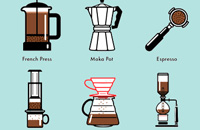
If you're like most people, you simply cannot live without your morning cup (okay, more like cups, plural) of coffee. It’s just about the only thing that motivates you to leave your warm bed in the mornings, and it is a faithful and welcome companion during endless meetings or ugly traffic.
But as with any habit, sometimes you may find yourself getting wasteful with your coffee. You may brew a whole pot, only to drink a single cup, or forget your travel mug and have to use a disposable cup.
There is a great deal of information about how to 'green' your morning coffee: changes that can make your coffee habit more sustainable and energy-efficient. Here are a few simply tips on how your brewing method can have a significant impact!

Skip the single-serve. Pod and capsule systems are not very eco-friendly because many of these are not recyclable, or they’re difficult to recycle. What’s more, certain models of these machines are designed to be powered on for a large portion of the day so that the water will stay warm, ready to be brewed at a moment’s notice. This, of course, wastes energy.

Use an energy-saving brewing method and eco-friendly machine. Brewing devices that don’t require electricity—including French presses, Chemex, and Aeropress—use less energy than their electric counterparts. There’s also the option to choose a cold-brew coffee maker, which doesn’t require any heat to boil water.
If you’re still using a traditional drip brew coffee maker, keep in mind the electricity required to heat it up accounts for a large portion of its eco footprint. Reduce the impact by keeping the machine turned off and unplugged except when it’s actually in use. Turn it off as soon as a cup is brewed and keep coffee warm in a thermal carafe instead of in the pot.
Boil right. Even if you choose a filter-less method, brewing can still use up a lot of energy depending on the way you boil. Electric kettles are generally considered the most efficient (and therefore the eco-friendliest) option, followed by microwaves and trailed by stovetop kettles. Make sure to boil only as much as you need so you don’t waste water.

